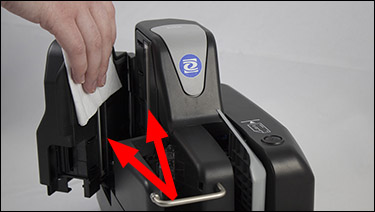Non-Conforming Image (NCI)

A Non-Conforming Image, or NCI in banking occurs when a scanned image of a check is transmitted for clearing, but is rejected during clearing, and then sent back (without being processed) to the bank that scanned the check. This may happen for a few different reasons, as explained below. It is important to note that […]
Protected: Why Use a Cash Recycler in Your Bank Branch?
It’s All About the Transaction!
There is no excerpt because this is a protected post.
Image Thresholding
Image thresholding is a process in which digital images are simplified from a full spectrum of colors or grayscale shades, down to a smaller set of selected shades. The example at right shows the most basic form of thresholding, in which any pixel below a certain brightness is converted to pure black, and any pixel […]
MICR / OCR Mismatch

A MICR / OCR mismatch occurs when the magnetic reading from the bottom line of a check or money order does not match the numbers captured in visible light. Most modern teller capture or remote deposit systems “double check” account numbers and routing numbers by taking two separate readings of the characters printed at the […]
Reader Sorter Machine

Reader/Sorter Machines, sometimes called by their nickname “Big Iron” in the banking industry, were large, extremely high-speed devices for scanning and sorting high numbers of documents, most commonly checks. They were usually found in the regional operations centers of larger banks, which collected and processed paper checks from many branches at a time. Reader/sorters were […]
MICR Head

The MICR head is the part of a scanner that reads magnetic ink, such as the characters printed at the bottom of a check. The acronym MICR stands for Magnetic Ink Character Recognition. Check scanners read the magnetic characters, or MICR line, on a check by imparting a magnetic charge to the ink just before […]
Bitonal Image

A bitonal image is an image consisting of only pure black and pure white pixels. There is no shading at all — each pixel is either 100% black (#000000) or 100% white (#FFFFFF). The name “bitonal image” comes from the fact that these two “tones” are the only ones used. It should not be confused […]
Duty Cycle (scanner)

Duty cycle refers to the maximum number of items per day that should be scanned by a device in normal usage. For example, a typical check scanner at a bank teller window might have a daily duty cycle of 3,000 or 5,000 items, while a heavy-duty reader/sorter machine would have a duty cycle in the […]
Contact Image Sensor

A contact image sensor, or CIS, is a specialized type of line scan sensor used in check scanners. While line-scan sensors in general are used to capture images of moving objects in single-pixel “slices,” contact image sensors are specifically designed to do that job from a fixed distance very close to (or nearly in contact […]
Line scan sensor

A line-scan sensor is a specialized technology that uses a row of sensors to capture a digital image in one-pixel “slices” taken in rapid succession. This requires that either the sensor be moving past the subject, or the subject be moving past the sensor. When the capture is complete, the slices are reconstituted into a […]
Area Scan Camera (Area Array)

An area scan, or area array, camera is what most of us would call a “regular” camera. It uses a single exposure to capture an image of a 2D area all at once. This type of device approximates the analog process of taking a picture with a film-based camera – however, modern digital devices are […]
Teller Capture

Teller Capture is the process of scanning checks as they are deposited at the teller window, as part of the customer’s transaction. It should not be confused with branch capture, the practice of scanning many checks from multiple deposits all together in one large batch. Teller capture has several advantages over branch capture, mainly because […]


